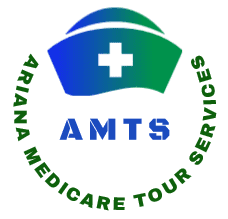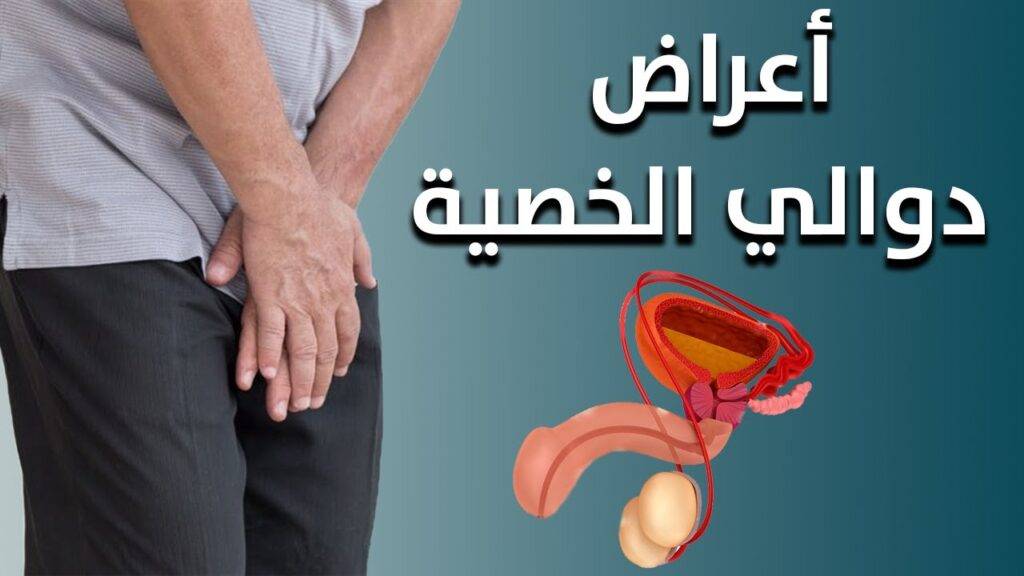
In the Iranian city of Shiraz, advanced vision correction techniques are available that allow people with vision problems to enjoy better vision without having to rely on glasses or contact lenses. Below we will review the most prominent refractive surgery techniques available in Shiraz: LASIK, FemtoLASIK, and FemtoSmile.
Table of Contents:
- LASIK procedure.
- Methods and types of LASIK to correct vision.
- General conditions for performing LASIK eye operations.
- General preparations before performing LASIK surgery.
- Benefits and side effects of different LASIK eye surgeries.
- Basic recommendations during LASIK surgery.
- Recommendations needed after PRK (LASIK) surgery, for Femtolasik and FemtoSmile.
- What is the appropriate age and sample number for a person to undergo LASIK and vision correction?
- Who are not suitable candidates for vision correction and LASIK?
1. Lasik procedure
When the eye suffers from refractive errors (myopia, farsightedness, and astigmatism), a person needs glasses for correct vision. Until the not-so-distant past, life without glasses was an unattainable myth for such people, but with the advancement of technology and the use of lasers in the field of ophthalmology, this myth has become a reality. Today, correcting refractive errors and removing glasses from life has become possible and accessible, and due to the use of lasers in eyeglass removal operations, these operations have become known as “eye LASIK”. In other words, LASIK enabled a person suffering from presbyopia, nearsightedness, and astigmatism to get rid of glasses. In LASIK surgery, based on initial examinations and test results, the surgeon changes the shape of the cornea using a laser, and in this way the light reflected from objects is focused on the retina. This is the main point in LASIK eye operations. In other words, after the operation, the problem of myopia, farsightedness, and astigmatism is solved, and the person can see properly without glasses.
2. Methods and types of LASIK today in Iran, in the city of Shiraz, for vision correction
LASIK, which is considered one of the most common, precise and safe surgical methods for treating refractive errors today, is a two-stage surgical procedure performed on the cornea. In this method, a layer (thin flap) is cut from the surface of the cornea.
Initially, fine automated blades (keratotomies) were used to cut the flap, but now, with access to a femtosecond laser, the flap can also be cut with a laser. In this way, the accuracy and safety of the process are greatly increased. With the combination of the excimer laser and the femtosecond laser, a new technique called “Femtolasik or PRK” was introduced, which is considered one of the best and most famous surgical techniques for refractive errors today.
3. General conditions for performing LASIK eye operations
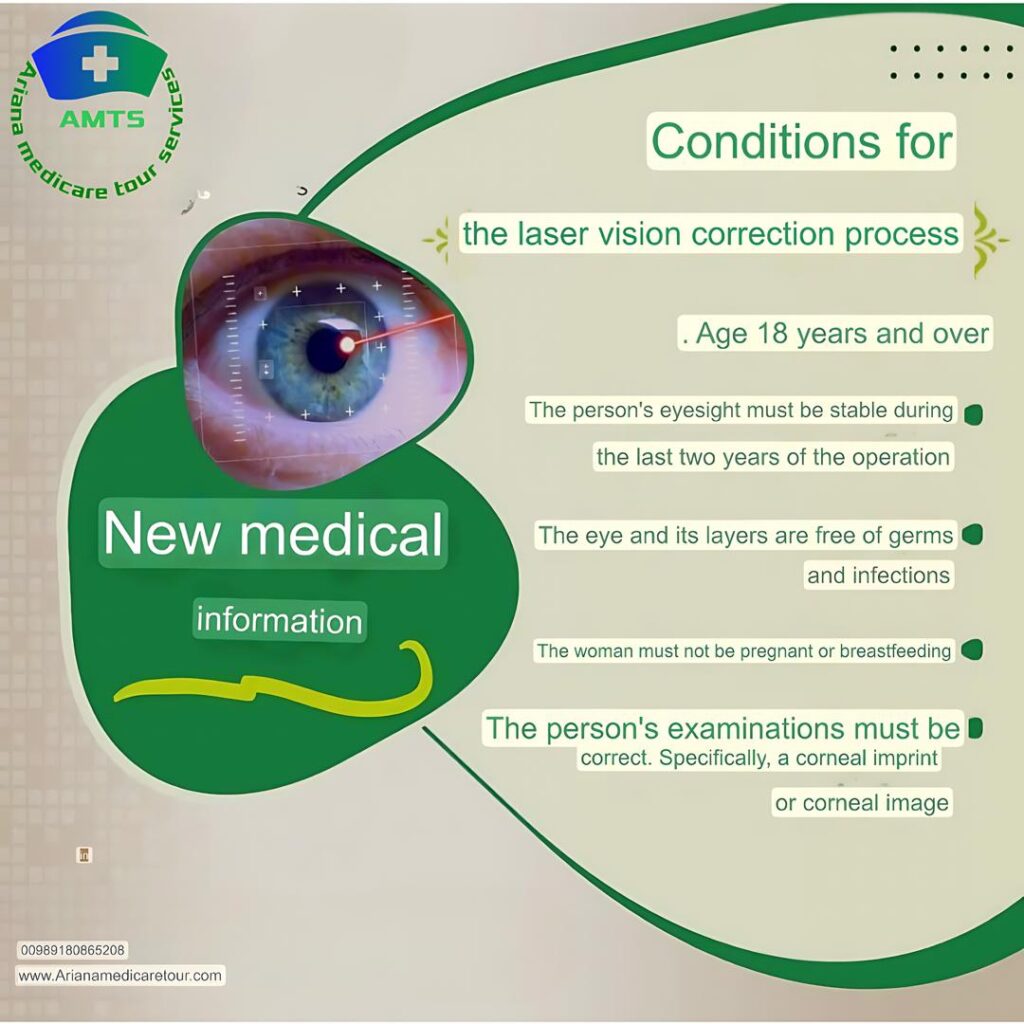
If you are applying for LASIK to correct refractive errors (including PRK or LASIK, Femto-LASIK and Femto-SMILE), pay attention to the following points:
- Sufficient corneal thickness.
- Not having uncontrolled diabetes.
- Absence of connective tissue disorders.
- There is no history of corneal herpes.
- There is no inflammation inside the eye.
- Not suffering from glaucoma or cataracts.
- Do not take some medications such as Raaccutane.
- Do not have unrealistic expectations from LASIK.
Important note:
The above-mentioned elements are examined by the ophthalmologist before the operation, during examinations, imaging, etc., and based on the results, the appropriate procedure for removing glasses is chosen. The ophthalmologist will also remind you of the above points and perhaps others before surgery
4. General preparations before performing the LASIK procedure
- Wash your eyelids and eyelashes the night before the LASIK procedure.
- Do not wear makeup 48 hours before the LASIK procedure.
- Wear light, comfortable clothing on the day of the LASIK procedure.
- Do not use perfumes and cologne on the day of LASIK surgery.
- Do not use contact lenses 48 hours before the LASIK procedure.
- Use calming pills in case of anxiety.
5. Benefits and side effects of different LASIK eye operations
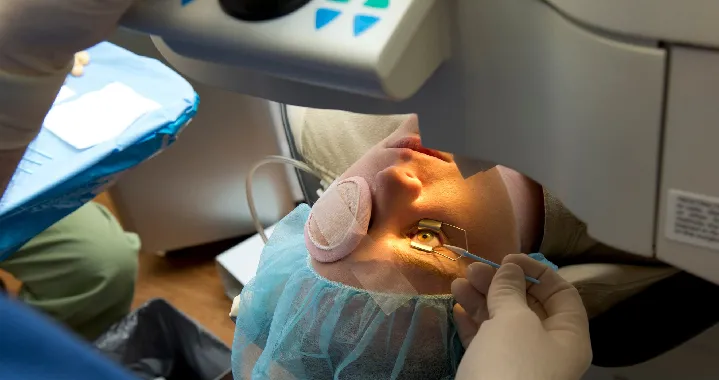
- Advantages and disadvantages of PRK or LASIK surgery.
- About 40% of patients use this method; Especially people with thin corneas, combat athletes and those with myopia and astigmatism.
- Discomfort and post-operative recovery: The possibility of discomfort (palpable pain) lasting for 3 to 5 days has been observed in a group of patients.
- Improved vision: Complete improvement of vision takes up to several months after surgery.
- The possibility of infection: This possibility is very low and if it does occur, it usually appears in the first 3-4 days after the operation.
- Possibility of moving the thin layer of the cornea (flap): There is no possibility of moving the flap in PRK surgery.
- Return to daily activities: This time after PRK for visually sensitive jobs such as surgeons, bank employees, accountants, etc., takes about 3 to 5 days, and the recovery period (rest time after operation) is 1 to 2 weeks.
- Benefits and complications of femtolytic surgery.
- About 40% of patients use the FemtoLASIK method, which is an effective treatment for correcting hyperopia, myopia and astigmatism (positive number).
- Discomfort after femtolysis surgery: The feeling of discomfort after femtolysis surgery does not exceed two hours for most people.
- Improved vision: Most patients have good vision the day after the operation.
- Chance of infection: The chance of infection after femtolasik is very small.
- Possibility of displacing the thin layer of the cornea (flap): This is not possible in femtolasik surgery.
- Return to daily activities: Usually one day after the operation, work and normal life can begin.
- Benefits and complications of femtosmile surgery.
- FemtoSmile is very suitable for people who suffer from myopia and astigmatism, and about 20% of patients use this method.
- Postoperative discomfort: Most people experience a minimal amount of discomfort after femtosmile surgery, and this usually lasts no more than two hours.
- Improvement of vision: Complete improvement of vision with femtosmile is slightly slower than with femtolasik.
- The possibility of infection after the operation: In femtosmile surgery, the possibility of infection is minimal.
- The possibility of moving the thin layer of the cornea or the flap: This possibility does not exist in femtosmile surgery.
- Return to daily activities: Two days after the FemtoSmile procedure, you can begin work and normal life.
6. Basic recommendations during LASIK surgery
- FemtoLASIK, PRK (LASIK) and FemtoSmile procedures are performed very quickly and precisely thanks to the laser and are completely painless with the arrangements made by the best ophthalmologists and treatment team at Basir Hospital, Ghasemifar Hospital and other of our hospitals in Iran in the city of Shiraz.
- Also remember that your cooperation while working plays a very important role in achieving the right result; Therefore, we advise you to remain calm during the procedure and pay attention to the ophthalmologist’s instructions and the matters described below.
- Before LASIK, your eyes are numbed with special drops and you are awake during surgery.
- During refractive surgery including PRK or LASIK, FemtoLASIK and FemtoSmile, look at the flashing red or green light and avoid moving your eyes and head.
- During refractive surgery including PRK or LASIK, FemtoLASIK and FemtoSmile, look at the flashing red or green light and avoid moving your eyes and head.
- Don’t worry about flashing during the process; Your eyelids are opened with a device. Avoid putting pressure on the eyelids and frowning during the procedure.
- Do not place your hands near the operating environment; This action causes eye contamination.
7. Recommendations necessary after femtoLASIK, PRK (LASIK) and femtoSmile surgery
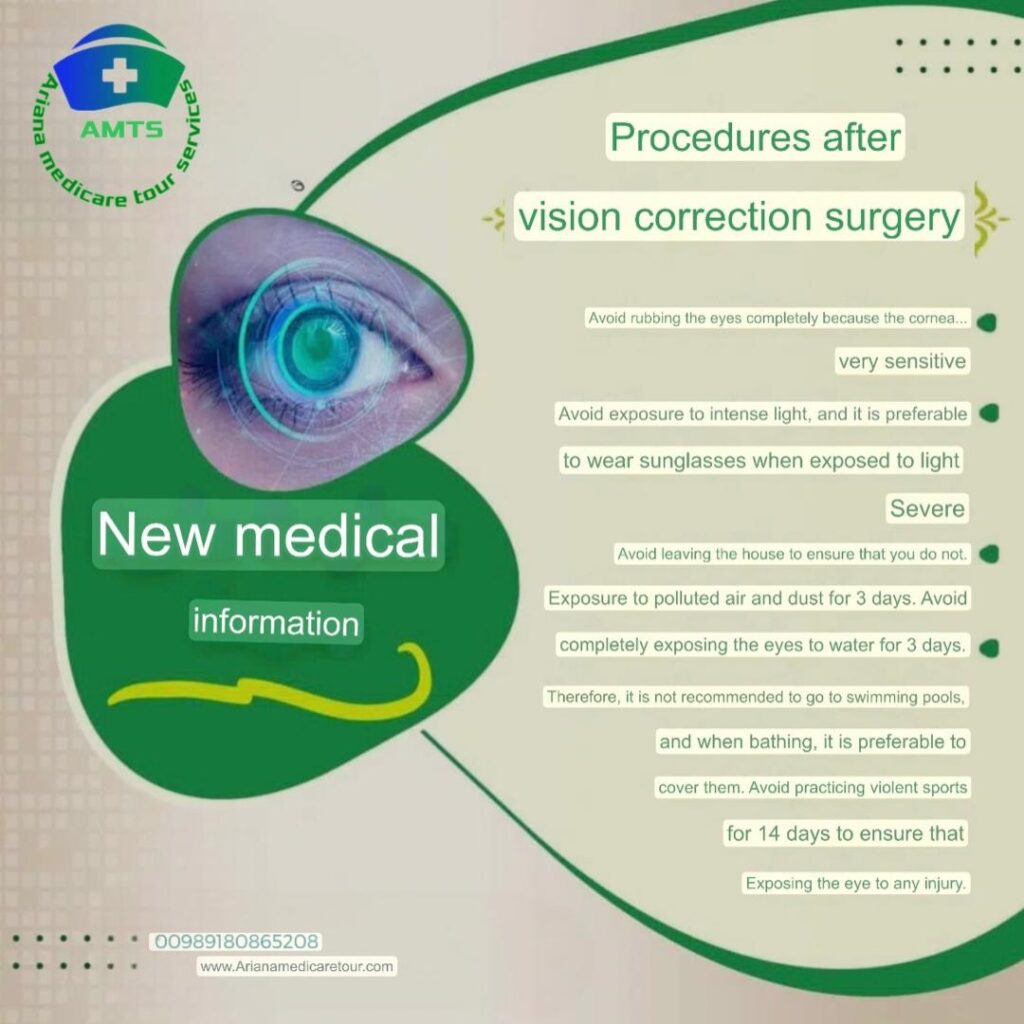
- Visit the doctor the day after the operation and receive medication orders (according to the examination results).
- Visit at regular intervals during the first 6 months after the operation as ordered by the doctor.
- Start with light daily activities if the discomfort is not severe and follow the precautionary recommendations determined by the doctor.
- Avoid driving for a week after the operation.
- Prevent swimming for at least 3 weeks.
- Avoid using contact and cosmetic lenses for at least 3 months after the procedure.
- Avoid violent sports such as boxing, football, karate, etc. for at least 10 weeks.
- Avoid rubbing and scratching the eyes in the first weeks after the operation.
- Avoid using lotions, creams, and other cosmetics around the eyes for at least 3 days or until your eye doctor allows it.
- Note that during the first few months after the operation, there is a possibility of vision fluctuation, and it may require vision stabilization for 3 to 6 months. During this period, you may experience symptoms such as poor vision while driving at night, dazzling lights in your field of vision, and luminous halos.
- According to each patient’s condition and the results of post-operative examinations, there is a possibility to change the times mentioned above, and the ophthalmologist will inform the patient of the special and necessary recommendations.
8. What is the appropriate age and eye number for a person to undergo LASIK surgery and correct vision?
To perform LASIK surgery, a person must have certain characteristics.
- The best age to undergo LASIK surgery is between 18 and 21 years. Therefore, the person must be at least 18 years old and no more than 50 years old.
- The eye number of a person wishing to undergo LASIK surgery must remain constant for one year.
- The LASIK candidate eye number must be less than 10.
9. Who are not suitable candidates for LASIK?
- People who have a small corneal thickness are not suitable for LASIK.
- People with cataracts, keratoconus, glaucoma, dry eyes, or other eye diseases cannot have LASIK.
- People who suffer from general diseases such as rheumatism, diabetes, or other general diseases also cannot undergo LASIK.
- Although LASIK surgery does not pose any risk to the fetus, LASIK surgery is not recommended for pregnant women due to hormonal changes during pregnancy.
- LASIK is not recommended for people over 40 years of age.
- Migraine patients who also take medication cannot have LASIK surgery.
Sources:
Rabin, Roni Caryn (June 11, 2018). “Lasik’s Risks Are Coming Into Sharper Focus – Some patients who undergo the eye surgery report a variety of side effects. They may persist for years, studies show”. The New York Times. Retrieved June 11, 2018
Walsh MJ. Is the future of refractive surgery based on corneal topography or wavefront? “Ocular Surgery News”. August 1, 2000, page 26
Walsh MJ. Wavefront is showing signs of success, but can it do it alone? Ocular Surgery News. September 1, 2000, page 41.
EW Dialogue: the future of wavefront refraction as a diagnostic tool. “EyeWorld”. May 2000, pages 64 and 65
Read more about other articles in the medical fields (Cosmetics and Medical).
- Hair Transplantation in Iran
- Rhinoplasty (Nose Job in Iran)
- Face Lift Surgery (Rhytidectomy) in Iran
- Breast Lift in Iran
- Chin Surgery in Iran
- Liposuction in Iran
- Tummy Tuck (Abdominoplasty) in Iran
- Butt Augmentation (Brazilian butt lift)
- Breast Augmentation in Iran
- Eye Care in Iran
- Cataract Surgery in Iran
- Diabetic Retinopathy Treatment in Iran
- Heart Surgery in Iran
- Knee Replacement in Iran
- Eyelid Surgery in Iran
- Safe Abortion in Iran
- Fertility Treatment in Iran
